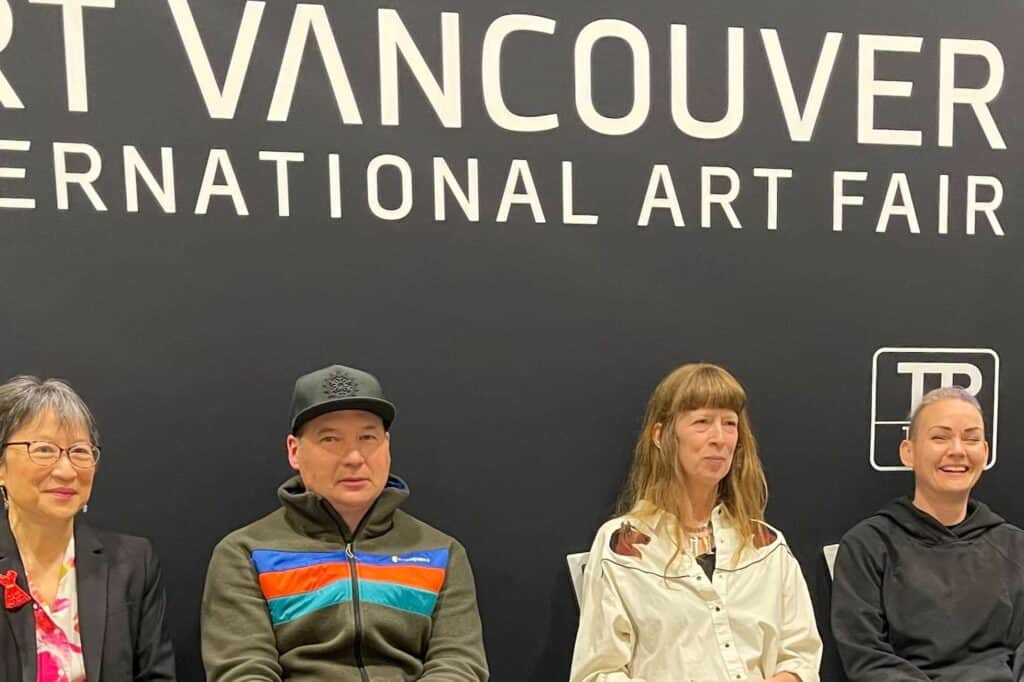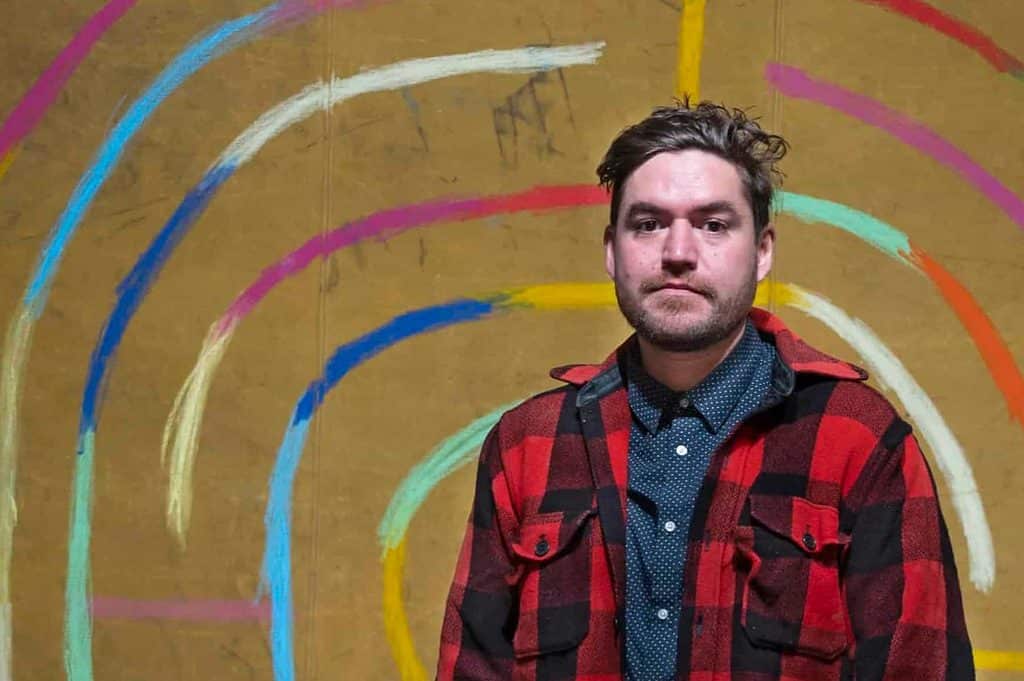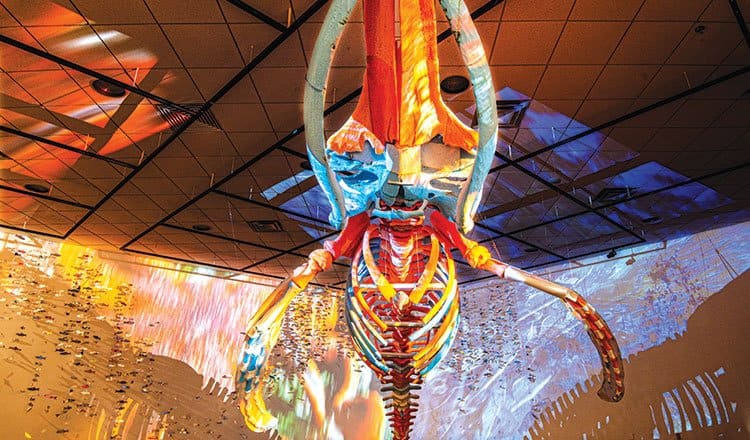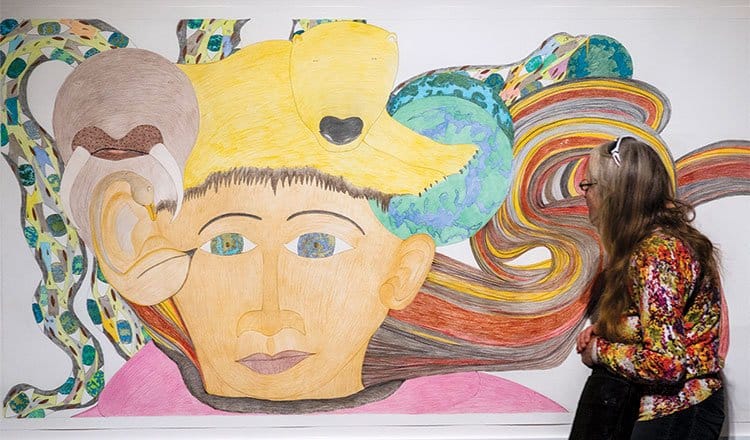
When the National Gallery of Canada announced the recipients of the 2020 Sobey Art Award in April, Yukon artist Joseph Tisiga was on the list of 25 names.
This is a big deal.
The Sobey Art Award is the most prestigious contemporary art prize in the country. This year, rather than selecting one winner, the Sobey Art Foundation is awarding $25,000 to each of the 25 long-listed artists to support their practices and livelihoods during these challenging times.
“Under typical circumstances the nod of recognition feels good, as there are always so many great artists on the list, and it’s nice to share some virtual space with everyone,” Tisiga said. “However, the choice to share the prize among everyone on the long-list feels great, and the financial support could not have come at a better time.”
A member of the Kaska Dena Nation with a relatively urban upbringing, Tisiga has been creating narratives which draw on a number of social and philosophical influences, art history, pop culture and Kaska stories. He has developed a pantheon of characters who weave threads of continuity and familiarity through his work, which now spans a dozen years of storytelling.
He’s had solo shows in several cities and participated in numerous group shows. His work is in the National Gallery of Canada Collection, among others. The Audain Art Museum in Whistler presented a survey of his work in 2019. Tisiga has also become part of the critical discourse around contemporary art practice in Canada.
At the same time, Tisiga seemingly defies the assumption, and perhaps the myth, that places like the Yukon are too small and too isolated to produce artists of national significance. When many artists feel that it’s necessary to live in urban centres to make their mark in the contemporary art world, Tisiga, until very recently, stuck it out in the North. I asked Tisiga about his ability to not only survive, but to thrive, as a visual artist in Whitehorse.
Part of the answer is found at the Yukon Arts Centre and the folks who work there. Many of Tisiga’s stories and mythologies were actualized through exhibits hosted by the Arts Centre gallery. As an artist with big ideas requiring both ample space and ample creative freedom, Tisiga put his trust in Gallery Director Mary Bradshaw and other gallery staff who were game for pretty much anything he could imagine.
Tisiga had his Arts Centre debut in 2008 after being approached by Bradshaw to do a show in the Community Gallery. The show was called Indigenous Incisions, and the gallery walls were filled floor to ceiling with work. Tisiga conjured fantastic watercolour tableaus featuring a strange assembly of characters, and collages using irreverent images such as Pablo Picasso’s head cut from art books. Indigenous Incisions was a display of astonishing storytelling from a young artist.
“I was stoked on the invitation and took it really seriously, so I made two series of work, one series of watercolor drawings and another series that were a mix of watercolor and collage pieces,” Tisiga recalled. “I remember people being pretty excited about the show and Bradshaw offered me a window to do an exhibition in the main gallery in 2009. I remember this being a huge opportunity for me…as I didn’t really have much experience exhibiting at the time, and frankly, hadn’t even made much art at all at that point.”
Tisiga was still an emerging talent in 2008, but from the beginning he possessed an uncanny ability to translate stories from his imagination into strong, engaging visual narratives. In 2009, Tisiga produced Indian Brand Corporation (IBC) in the Main Gallery. The exhibit was a full-blown multi-media installation – a strange, fictional office space featuring performance photographs, film and found objects. The walls were adorned with large paintings of Archie comic characters engaging in suspect interactions with Indigenous people.
“We (Tisiga and Bradshaw) talked a lot about my thoughts for the exhibition… and although I think she was thinking I would make more watercolor paintings as had been shown in the Grotto, I was clearly going in another direction. Neither of us could have really known what to expect but she supported my choice to experiment. Ultimately the exhibition introduced the idea of ‘Indian Brand Corporation’ which has been a thought project for me since, and at the time was actually an inadvertent way to draw together various components of my artistic interests at that point. That early support and trust was really formative and something I appreciate so much.”
Tisiga has described Indian Brand Corporation as “a fictional company that produces complex narratives that combine conflicting Indigenous and non-indigenous world views.” IBC has evolved over the years, with new characters being introduced and the company taking on several permutations, including a magic show in Dawson’s ODD Gallery and a mini-putt course. The latter was created in 2016 at the Yukon Arts Centre and was entitled IBC: First Hole: Death Prophecy Denied.
Along with the mini-putt course, the exhibit featured large, ominous watercolour drawings. On the wall entering the space, the message ‘The Game Can Not Be Won’ was hand-painted on blueprints of Yukon Hall, a former residence for Indigenous children attending Whitehorse public schools. A statement accompanying the exhibit explained that Tisiga was “[drawing] connections between golf, social status and land strife within his alternative narrative of Indian Brand Corporation.”
Practically, the installation of the show presented some challenges in translating Tisiga’s large-scale concepts into the gallery space. The willingness of the Arts Centre staff to make things happen allowed Tisiga to introduce last-minute ideas and unusually large objects, notably a wall tent, into the show.
“On a material or installation level, Bradshaw and the YAC staff have supported my experiments that would be really challenging to propose in other spaces,” Tisiga said. “For instance, the time an off-the-cuff thought to suspend a 14’x16′ wall-tent from the ceiling materialized in a matter of hours, or using a bunch of recycled carpet to make a mini-putt course…I think the relationships and trust formed with Bradshaw and YAC allowed me to experiment with things, that I can keep building on for future projects.”
Beyond the Arts Centre, Tisiga credits the Yukon itself as beneficial to his practice, despite the perceived limitations of being a visual artist in remote Canadian towns:
“Unfortunately I think there has been a strong ‘urban-centric’ attitude within the arts, but I feel like that’s somewhat shifted over time. Being able to communicate with people or expose people to your work through the internet has eased the barriers a little. In many ways, developing my art practice in the Yukon was ideal, particularly because of the people and community support, but there’s a comfort in trying things and stretching your resourcefulness. I feel like it is a great place to ‘learn out loud’. I think things tend to move slowly, there’s lots of time to go deeply into your thinking and interests.”
Until recently, Tisiga has lived in Whitehorse, with a few stints in other cities including a year at the Nova Scotia School of Art and Design. He relocated to Montreal last year but still has strong ties to the Yukon.
“I had been craving a move to a city for a long time, feeling like I needed new exposures in my life to continue growing artistically,” Tisiga admits. “Ironically, being isolated in Montreal during the COVID-19 outbreak has me missing and feeling very nostalgic for Whitehorse, my home, family and community.”
Whitehorse is missing Tisiga, too. There is a lot of excitement and happiness for his achievement, especially at Yukon Arts Centre which nominated Tisiga for the Sobey Art Award twice – he was longlisted in 2011 as well. To celebrate his award, the Arts Centre and the Yukon Permanent Art Collection have installed three of his works from their collections in the Community Gallery.
I met Bradshaw in the gallery, and we chatted about Tisiga’s work over the years.
We talked about the work Tisiga is currently producing in Montreal and posting on Instagram. There are watercolour drawings created at his kitchen table. He is also experimenting, for example with salt dough, making blobby objects resembling poo.
“I have no idea where he’s going with it,” Bradshaw said, “But I’m looking forward to seeing how it’s all going to be combined and played with.”
There’s an element of surprise that keeps us anticipating Tisiga’s next move. Bradshaw summed it up by saying, “With many artists, but with Joseph in particular… I can’t guess where he’s going next. And I love that.”
Works by Tisiga will be on display in the Community Gallery until June 30. You can also visit Emerging North, which is a celebration of young Indigenous artists, on display in the Main Gallery.




